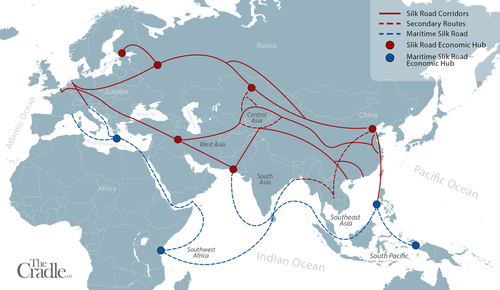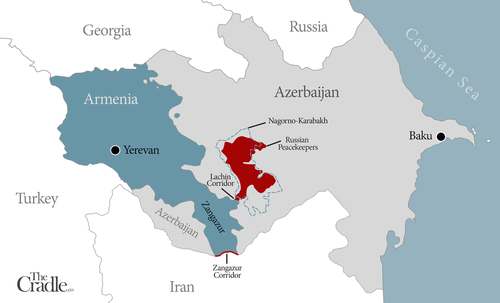Escobar: The Inside Story Of Russia-Iran-India Connectivity
Authored by Pepe Escobar via The Cradle,
The G7 is stupefied by the dynamic progress of the multipolar order embodied by the Russian-led INSTC and the Chinese-led BRI, with Iran's strategic port of Chabahar now poised to play a transformative role...
Make no mistake about what the G7’s Hiroshima Communique is all about.
The setting: a city in neo-colony Japan nuclear-bombed 78 years ago by the United States, for which it made no excuses.
The message: the G7, actually G9 (augmented by two unelected Eurocrats) declares war – hybrid and otherwise – against BRICS+, which has 25 nations on its waiting list and counting.
The G7’s key strategic objective is the defeat of Russia, followed by the subjugation of China. For the G7/G9, these – real – powers are the main “global threats” to “freedom and democracy.”
The corollary is that the Global South must toe the line – or else. Call it a remix of the early 2000s “you’re either with us or against us.”
Meanwhile, in the real world – that of productive economies – the dogs of war bark while the New Silk Road caravans keep marching on.
The key New Silk Roads of emerging multipolarity are China’s ambitious, multi-trillion-dollar Belt and Road Initiative (BRI) and the Russia-Iran-India International North South Transportation Corridor (INSTC). They have evolved in parallel and may sometimes overlap. What is clear is the G7/G9 will go to the ends of the earth to undermine them.
Map of INSTC (Photo Credit: The Cradle)
All about Chabahar
The recent $1.6 billion deal between Iran and Russia to build the 162-km long Rasht-Astara railway is an INSTC game-changer. Iran’s Minister of Roads and Urban Development Mehrdad Bazpash and Russia’s Minister of Transport Vialy Saveliev signed the deal in Tehran, in front of Iranian President Ebrahim Raisi and with Russian President Vladimir Putin attending on video conference.
Call it the marriage of Iran’s “Look East” with Russia’s “pivot to the East.” Both are now official policies.
Rasht is close to the Caspian Sea. Astara is on the border with Azerbaijan. Connecting them will be part of a Russia-Iran-Azerbaijan deal on railway and cargo transportation – solidifying the INSTC as a key connectivity corridor between South Asia and Northern Europe.
The multimodal INSTC advances via three main routes: the Western route links Russia-Azerbaijan-Iran-India; the Middle or Trans-Caspian route links Russia-Iran-India; and the Eastern one links Russia-Central Asia-Iran-India.
The Eastern route features the immensely strategic port of Chabahar in southeast Iran, in the volatile Sistan-Balochistan province. That’s the only Iranian port with direct access to the Indian Ocean.
In 2016, Iran, India, and an Afghanistan still under US occupation signed a tripartite deal in which Chabahar miraculously escaped unilateral US “maximum pressure” sanctions. That was a stepping stone configuring Chabahar as the privileged gateway for Indian products to enter Afghanistan, and then further on down the road, toward Central Asia.
Russia, Iran, and India signed a formal INSTC deal in May 2022, detailing a multimodal network – ship, rail, road – which proceeds via the previously mentioned three axes: Western, Middle or Trans-Caspian, and Eastern. The Russian port of Astrakhan, by the Caspian Sea, is crucial on all three.
The Eastern route connects eastern and central Russia, through Kazakhstan and Turkmenistan, to the southern part of Iran as well as India and the Arab lands on the southern edge of the Persian Gulf. Dozens of trains are already plying the overland route from Russia to India via Turkmenistan and Iran.
The problem is that in the past few years, New Delhi, for several complex reasons, seemed to be asleep at the wheel. And that led Tehran to become much more interested in Russian and Chinese involvement to develop two strategic ports in the Chabahar Free Trade Industrial Zone: Shahid Beheshti and Shahid Zalantari.
China makes its move
Chabahar is a tough nut to crack. Iran has invested heavily to turn it into an inescapable regional transit hub. India, in thesis, from the beginning regarded Chabahar as a key plank of its “Diamond Necklace” strategy, counterpunching the Chinese “String of Pearls,” which are ports linked by the BRI across the Indian Ocean.
Photo Credit: The Cradle
Chabahar also performs the role of counterpoint to Pakistan’s Gwadar Port in the Arabian Sea, the jewel in the China-Pakistan Economic Corridor (CPEC) crown.
From Tehran’s point of view, what is needed – fast – is the completion of its eastern railway network, 628 km of tracks from Chabahar to Zahedan. In optimum terms, that might be finished by March 2024 as part of the Mashhad-Sharkhs railway axis connecting Iran’s southeast to its northeast on the border with Turkmenistan.
For the moment, INSTC cargo travels to South Asia from Iran’s Bandar Abbas Port in the Strait of Hormuz – a long 680 km away from Chabahar. So for all practical purposes, Chabahar will make transit from India to Afghanistan, Central Asia, and southern Russia shorter, cheaper, and faster.
But once again, things stalled because India did not come up with the expected financial arrangements. That ended up generating some misgivings in Tehran – especially when watching the massive Chinese investments in Gwadar.
So it’s no wonder Iran decisively moved to attract China as a major investor, which has become part of their increasingly sprawling strategic partnership. So we may end up with Chabahar also becoming part of China’s BRI, on top of its starring role in the INSTC.
Russia, for its part, is now facing the Ukraine stalemate, relentless western sanctions hysteria, and serious trade restrictions to Eastern Europe. All that while Moscow consistently expands its trade with New Delhi.
So it is no wonder Moscow is now much more attentive to the INSTC. Last December, a key deal was clinched between Russian Railways and the national companies in Kazakhstan, Turkmenistan, and Iran, and the Russians came up with a 20 percent discount for import-export containers going through the Russia-Kazakh border.
What matters most for Russia is that Chabahar operating at full speed reduces the cost of transporting goods from India by 20 percent. The Iranians fully understood the game, and started to heavily promote the Chabahar Free Trade-Industrial Zone to attract Russian investment. And that culminated in the Rasht-Astara deal.
The Zangezur spoiler
China’s BRI, for its part, plays a parallel game. Beijing is heavily investing in the East-West transit route – also known as the Middle Corridor.
This BRI corridor goes from Xinjiang to Kazakhstan, Kyrgyzstan, Uzbekistan, and Turkmenistan, and then across the Caspian to Azerbaijan, Georgia, Turkiye, and further on to Eastern Europe – a total of 7,000 km, with a cargo journey of maximum 15 days.
BRI’s emphasis is to bet on multiple corridors East-to-West to fight possible new western-dictated disruptions of supply chains. China-Central Asia transit to Europe bypassing Russia and Iran is one of the top bets. The BRI corridor through Russia, because of NATO’s proxy war in Ukraine, is on hold for the moment. And the Chinese are testing all options to bypass the Maritime Silk Road through Malacca.
Turkiye, with the serious possibility of its longtime President Recep Tayyip being re-elected this weekend, has also made its play.
The Baku-Tblisi-Kars railway, opened in 2018, was a key plank in Ankara’s masterplan to configure itself as an inescapable hub of container freight between China and Europe.
In parallel, China invested in building a railway from Kars to Edirne on the European side of the Bosphorus while Turkiye went for a $3.8 billion upgrade of the port of Mersin and $1.2 billion for the port of Izmir. By 2034, Beijing expects this corridor to be the central plank of what it describes as the Iron Silk Road.
A certified spanner in the INSTC works is competition from the so-called Zangezur Corridor – from Azerbaijan to Turkiye via Armenia; this corridor is actually privileged by EU and British oligarchy and came to light during the 2020 armistice in Nagorno-Karabakh.
Map of Azerbaijan-Armenia conflict zones (Photo Credit: The Cradle)
London identifies Baku as a privileged partner and is keen to dictate terms to Yerevan: accept a sort of peace treaty as soon as possible, and renounce any designs on Karabakh.
The Zangezur Corridor would be the prime geopolitical and geoeconomic Western play linking EU logistical hubs with Transcaucasia and Central Asia. What if Armenia is thrown under the bus? After all, Armenia is a member of the Russian-led Eurasia Economic Union (EAEU), which the collective West is dying to undermine.
Fasten your seat belts: a geoeconomic New Great Game centered on the INTSC is just about to start.
https://www.zerohedge.com/geopolitical/escobar-inside-story-russia-iran-india-connectivity







Geen opmerkingen:
Een reactie posten